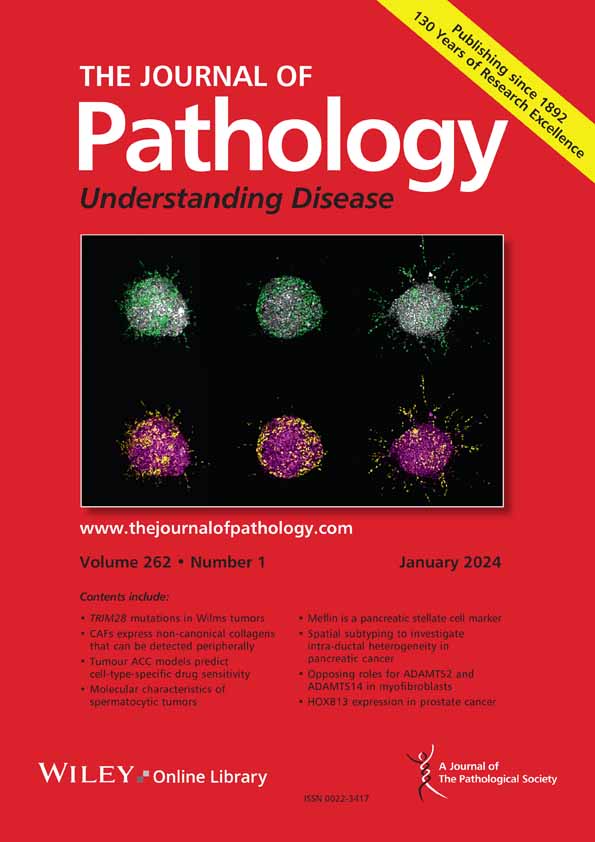求助PDF
{"title":"Multi-omics analysis unveils the role of inflammatory cancer-associated fibroblasts in chordoma progression","authors":"Bo-Wen Zheng, Wei Guo","doi":"10.1002/path.6369","DOIUrl":null,"url":null,"abstract":"<p>Cancer-associated fibroblasts (CAFs) constitute the primary cellular component of the stroma in chordomas, characterized by an abundance of mucinous stromal elements, potentially facilitating their initiation and progression; however, this inference has yet to be fully confirmed. In this study, single-cell RNA sequencing (scRNA-seq), spatial transcriptomics (ST), bulk RNA-seq, multiplexed quantitative immunofluorescence (QIF), and <i>in vivo</i> and <i>in vitro</i> experiments were performed to determine the heterogeneity, spatial distribution, and clinical significance of CAFs in chordoma. ScRNA-seq was performed on 87,693 single cells derived from seven tumor samples and four control nucleus pulposus samples. A distinct CAF cluster distinguished by the upregulated expression of inflammatory genes and enriched functionality in activating inflammation-associated cells was identified. Pseudotime trajectory and cell communication analyses suggested that this inflammatory CAF (iCAF) subset originated from normal fibroblasts and interacted extensively with tumors and various other cell types. By integrating the scRNA-seq results with ST, the presence of iCAF in chordoma tissue was further confirmed, indicating their positioning at a distance from the tumor cells. Bulk RNA-seq data analysis from 126 patients revealed a correlation between iCAF signature scores, chordoma invasiveness, and poor prognosis. QIF validation involving an additional 116 patients found that although iCAFs were not in close proximity to tumor cells compared with other CAF subsets, their density correlated with malignant tumor phenotypes and adverse outcomes. <i>In vivo</i> and <i>in vitro</i> experiments further confirmed that iCAFs accelerate the malignant progression of chordomas. These findings could provide insights into the development of novel therapeutic strategies. © 2024 The Pathological Society of Great Britain and Ireland.</p>","PeriodicalId":232,"journal":{"name":"The Journal of Pathology","volume":"265 1","pages":"69-83"},"PeriodicalIF":5.6000,"publicationDate":"2024-11-29","publicationTypes":"Journal Article","fieldsOfStudy":null,"isOpenAccess":false,"openAccessPdf":"","citationCount":"0","resultStr":null,"platform":"Semanticscholar","paperid":null,"PeriodicalName":"The Journal of Pathology","FirstCategoryId":"3","ListUrlMain":"https://onlinelibrary.wiley.com/doi/10.1002/path.6369","RegionNum":2,"RegionCategory":"医学","ArticlePicture":[],"TitleCN":null,"AbstractTextCN":null,"PMCID":null,"EPubDate":"","PubModel":"","JCR":"Q1","JCRName":"ONCOLOGY","Score":null,"Total":0}
引用次数: 0
引用
批量引用
Abstract
Cancer-associated fibroblasts (CAFs) constitute the primary cellular component of the stroma in chordomas, characterized by an abundance of mucinous stromal elements, potentially facilitating their initiation and progression; however, this inference has yet to be fully confirmed. In this study, single-cell RNA sequencing (scRNA-seq), spatial transcriptomics (ST), bulk RNA-seq, multiplexed quantitative immunofluorescence (QIF), and in vivo and in vitro experiments were performed to determine the heterogeneity, spatial distribution, and clinical significance of CAFs in chordoma. ScRNA-seq was performed on 87,693 single cells derived from seven tumor samples and four control nucleus pulposus samples. A distinct CAF cluster distinguished by the upregulated expression of inflammatory genes and enriched functionality in activating inflammation-associated cells was identified. Pseudotime trajectory and cell communication analyses suggested that this inflammatory CAF (iCAF) subset originated from normal fibroblasts and interacted extensively with tumors and various other cell types. By integrating the scRNA-seq results with ST, the presence of iCAF in chordoma tissue was further confirmed, indicating their positioning at a distance from the tumor cells. Bulk RNA-seq data analysis from 126 patients revealed a correlation between iCAF signature scores, chordoma invasiveness, and poor prognosis. QIF validation involving an additional 116 patients found that although iCAFs were not in close proximity to tumor cells compared with other CAF subsets, their density correlated with malignant tumor phenotypes and adverse outcomes. In vivo and in vitro experiments further confirmed that iCAFs accelerate the malignant progression of chordomas. These findings could provide insights into the development of novel therapeutic strategies. © 2024 The Pathological Society of Great Britain and Ireland.
多组学分析揭示了炎性癌症相关成纤维细胞在脊索瘤进展中的作用。
癌相关成纤维细胞(CAFs)是脊索瘤基质的主要细胞成分,其特征是粘液基质成分丰富,可能促进其发生和发展;然而,这一推论尚未得到充分证实。本研究通过单细胞RNA测序(scRNA-seq)、空间转录组学(ST)、大量RNA测序(bulk RNA-seq)、多重定量免疫荧光(multiplexed quantitative immunofluorescence, QIF)以及体内和体外实验来确定脊索瘤中CAFs的异质性、空间分布及其临床意义。对来自7个肿瘤样本和4个对照髓核样本的87,693个单细胞进行ScRNA-seq分析。发现了一个独特的CAF簇,其特征是炎症基因的表达上调和激活炎症相关细胞的功能增强。伪时间轨迹和细胞通讯分析表明,这种炎性CAF (iCAF)亚群起源于正常成纤维细胞,并与肿瘤和各种其他细胞类型广泛相互作用。通过将scRNA-seq结果与ST结合,进一步证实了iCAF在脊索瘤组织中的存在,表明它们位于离肿瘤细胞较远的位置。来自126例患者的大量RNA-seq数据分析显示iCAF特征评分、脊索瘤侵袭性和不良预后之间存在相关性。涉及另外116例患者的QIF验证发现,尽管与其他CAF亚群相比,icaf与肿瘤细胞的距离并不近,但其密度与恶性肿瘤表型和不良结局相关。体内和体外实验进一步证实了iCAFs加速脊索瘤的恶性进展。这些发现可以为新的治疗策略的发展提供见解。©2024英国和爱尔兰病理学会。
本文章由计算机程序翻译,如有差异,请以英文原文为准。


